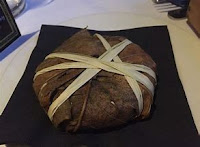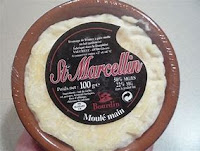Bleu d'Auvergne is a wonderful pasteurized cow's milk blue cheese produced in the Auvergne region of France. Bleu d'Auvergne is an AOC (Appellation d'Origine Controlle) name controlled cheese and this assures the quality and production methods that are used to produce it.
Details: The cows in the Auvergne region graze in verdant pastures and produce large quantities of top quality milk. The method and recipe for producing Bleu d'Auvergne is centuries old and has changed little over time but there are now large producers so this blue cheese is available almost everywhere. The cheese is made into six pound wheels and is wrapped in foil. The outer surface is not really considered to be a true rind so it is edible but it is quite salty The interior paste is white or tending to light beige and will have a high concentration of blue veins.
Bamboo Cheese Cutting Board And Knife Set from Amazon
Flavor: Bleu d"Auvergne is a mild blue cheese so it is not nearly as sharp as Roquefort or Spanish Cabrales. You will be able to pick out hints of grass and to a lesser extent a nutty undertone.
When shopping for Bleu d'Auvergne do not purchase any that show signs reddening, browning or cracks in the outer surface. In addition ask for a small sample, if the cheese feels overly soft or has a rancid or any other odor not buy it.
If you can not find Bleu d'Auvergne good sustitutes are Maytag Blue, Spanish Picon or Fourme d'Ambert.
Details: The cows in the Auvergne region graze in verdant pastures and produce large quantities of top quality milk. The method and recipe for producing Bleu d'Auvergne is centuries old and has changed little over time but there are now large producers so this blue cheese is available almost everywhere. The cheese is made into six pound wheels and is wrapped in foil. The outer surface is not really considered to be a true rind so it is edible but it is quite salty The interior paste is white or tending to light beige and will have a high concentration of blue veins.
Bamboo Cheese Cutting Board And Knife Set from Amazon
Flavor: Bleu d"Auvergne is a mild blue cheese so it is not nearly as sharp as Roquefort or Spanish Cabrales. You will be able to pick out hints of grass and to a lesser extent a nutty undertone.
When shopping for Bleu d'Auvergne do not purchase any that show signs reddening, browning or cracks in the outer surface. In addition ask for a small sample, if the cheese feels overly soft or has a rancid or any other odor not buy it.
If you can not find Bleu d'Auvergne good sustitutes are Maytag Blue, Spanish Picon or Fourme d'Ambert.
Keurig K-Cafe Coffee Maker the Amazon
How to serve Bleu d'Auvergne: It is a great addition to garden salads or blended into a vinaigrette or made into a salad dressing. It is also wonderful as an after dinner cheese served with sweet fruits.
Wine Pairings: Full bodied Rhone reds, fruity whites, sweet Sauternes, Riesling or a Sauvignon Blanc
How to serve Bleu d'Auvergne: It is a great addition to garden salads or blended into a vinaigrette or made into a salad dressing. It is also wonderful as an after dinner cheese served with sweet fruits.
Wine Pairings: Full bodied Rhone reds, fruity whites, sweet Sauternes, Riesling or a Sauvignon Blanc



